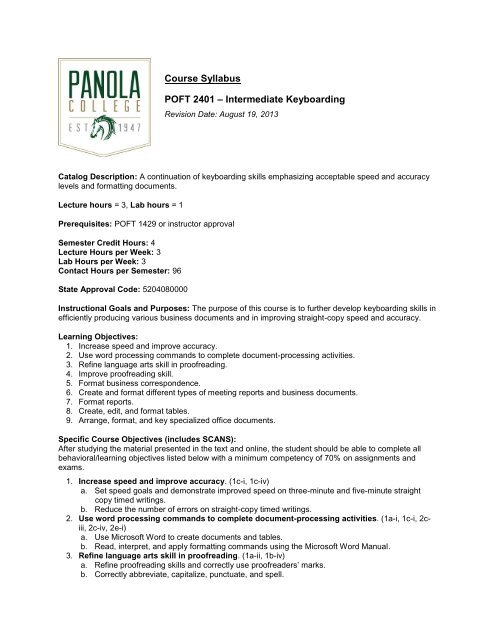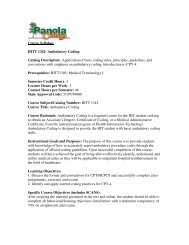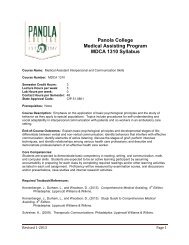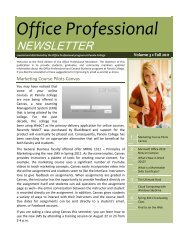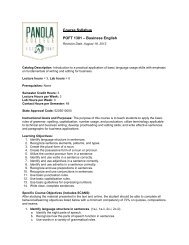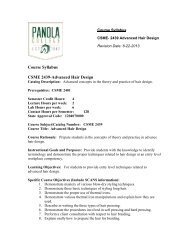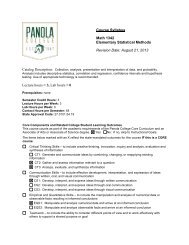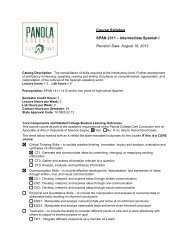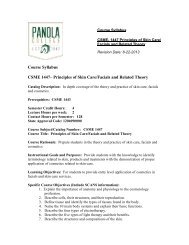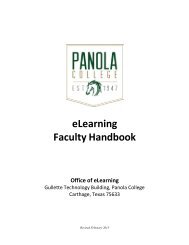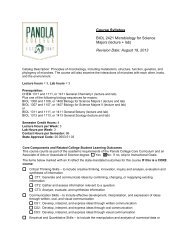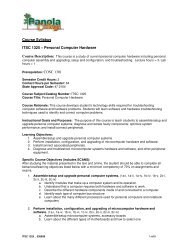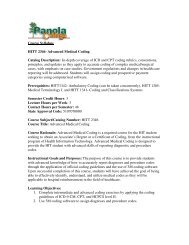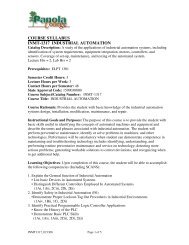Course Syllabus POFT 2401 â Intermediate ... - Panola College
Course Syllabus POFT 2401 â Intermediate ... - Panola College
Course Syllabus POFT 2401 â Intermediate ... - Panola College
You also want an ePaper? Increase the reach of your titles
YUMPU automatically turns print PDFs into web optimized ePapers that Google loves.
<strong>Course</strong> <strong>Syllabus</strong><br />
<strong>POFT</strong> <strong>2401</strong> – <strong>Intermediate</strong> Keyboarding<br />
Revision Date: August 19, 2013<br />
Catalog Description: A continuation of keyboarding skills emphasizing acceptable speed and accuracy<br />
levels and formatting documents.<br />
Lecture hours = 3, Lab hours = 1<br />
Prerequisites: <strong>POFT</strong> 1429 or instructor approval<br />
Semester Credit Hours: 4<br />
Lecture Hours per Week: 3<br />
Lab Hours per Week: 3<br />
Contact Hours per Semester: 96<br />
State Approval Code: 5204080000<br />
Instructional Goals and Purposes: The purpose of this course is to further develop keyboarding skills in<br />
efficiently producing various business documents and in improving straight-copy speed and accuracy.<br />
Learning Objectives:<br />
1. Increase speed and improve accuracy.<br />
2. Use word processing commands to complete document-processing activities.<br />
3. Refine language arts skill in proofreading.<br />
4. Improve proofreading skill.<br />
5. Format business correspondence.<br />
6. Create and format different types of meeting reports and business documents.<br />
7. Format reports.<br />
8. Create, edit, and format tables.<br />
9. Arrange, format, and key specialized office documents.<br />
Specific <strong>Course</strong> Objectives (includes SCANS):<br />
After studying the material presented in the text and online, the student should be able to complete all<br />
behavioral/learning objectives listed below with a minimum competency of 70% on assignments and<br />
exams.<br />
1. Increase speed and improve accuracy. (1c-i, 1c-iv)<br />
a. Set speed goals and demonstrate improved speed on three-minute and five-minute straight<br />
copy timed writings.<br />
b. Reduce the number of errors on straight-copy timed writings.<br />
2. Use word processing commands to complete document-processing activities. (1a-i, 1c-i, 2ciii,<br />
2c-iv, 2e-i)<br />
a. Use Microsoft Word to create documents and tables.<br />
b. Read, interpret, and apply formatting commands using the Microsoft Word Manual.<br />
3. Refine language arts skill in proofreading. (1a-ii, 1b-iv)<br />
a. Refine proofreading skills and correctly use proofreaders’ marks.<br />
b. Correctly abbreviate, capitalize, punctuate, and spell.
c. Identify subject/verb agreement problems and refine composing skills.<br />
4. Improve proofreading skill. (1b-iii, 1b-iv, 1c-i)<br />
a. Proofread and correct errors in keyed documents.<br />
b. Apply and interpret standard proofreaders’ marks.<br />
5. Format business correspondence. (1a-i, 1 b-ii, 1b-iii, 1b-iv, 1b-v, 1b-vi, 1c-iv, 2a-i, 2a-iii, 2c-i, 2cii,<br />
2c-iii, 2c-iv)<br />
a. Arrange and key a business letter in both block and modified-block style.<br />
b. Arrange and key a personal business letter.<br />
c. Edit letters by using and interpreting proofreaders’ marks.<br />
d. Correctly format and key a multipage letter.<br />
e. Format a letter containing multiple addressees.<br />
f. Key letters containing special letter parts using acceptable formatting.<br />
g. Key and format an interoffice memorandum.<br />
h. Prepare and key a multipage interoffice memorandum.<br />
i. Adjust letter margins and spacing to fit different sized stationery.<br />
j. Use tables to create a resume.<br />
k. Arrange and key an employment application and follow-up letter.<br />
6. Create and format different types of meeting reports and business documents. (1a-i, 1b-ii, 1biii,<br />
1b-iv, 1b-v, 1b-vi, 1c-iv, 2a-i, 2a-iii, 2c-i, 2-cii, 2c-iii, 2c-iv)<br />
a. Arrange and key a meeting agenda.<br />
b. Prepare minutes of a meeting using an appropriate format.<br />
c. Key and format an itinerary.<br />
d. Prepare a procedures manual for employees.<br />
7. Format reports. (1b-ii, 1b-iii, 1b-iv, 1b-v, 1b-vi, 1c-iv, 2a-i, 2a-iii, 2c-i, 2c-ii, 2c-iii, 2c-iv, 2e-i, 2e-ii)<br />
a. Key and correctly format a business report.<br />
b. Key and correctly format an academic report.<br />
c. Create and appropriately format multipage reports that contain footnotes.<br />
d. Key and correctly format a memo report.<br />
e. Evaluate report headings and determine appropriate formatting.<br />
f. Key and correctly format a bound formal business report that includes a title page, table of<br />
contents, and reference page or bibliography.<br />
g. Insert a table and graphics into a report and apply appropriate formatting guidelines.<br />
8. Create, edit, and format tables. (1b-ii, 1b-iii, 1b-iv, 1b-v, 1b-vi, 1c-iv, 2a-i, 2a-iii, 2c-i, 2c-ii, 2c-iii,<br />
2c-iv, 2e-i, 2e-ii)<br />
a. Create a boxed table.<br />
b. Create an open table.<br />
c. Center a table vertically and horizontally on a page.<br />
d. Adjust column widths in a table.<br />
e. Format title lines and column headings in a table.<br />
f. Change text alignment within table cells.<br />
g. Merge and/or split cells in a table.<br />
h. Format custom borders and add fill to table cells.<br />
i. Sort information in a table by either ascending or descending order.<br />
j. Prepare and correctly format a multipage table.<br />
9. Arrange, format, and key specialized office documents. (1b-ii, 1b-iii, 1b-iv, 1b-v, 1b-vi, 1c-iv, 2ai,<br />
2a-iii, 2c-i, 2c-ii, 2c-iii, 2c-iv, 2e-i, 2e-ii)<br />
a. Use tables to design and key a patient information form.<br />
b. Format and key sample medical office documents.<br />
c. Apply line numbering to various legal documents.<br />
d. Arrange, format, and key the following legal documents: affidavit, warranty deed, summons, last<br />
will and testament, complaint, and a judgment.<br />
2
<strong>Course</strong> Content:<br />
Students in all sections of <strong>Intermediate</strong> Keyboarding will be required to do the following:<br />
1. Students will submit keyboarding lessons throughout the semester by uploading work to the<br />
Gregg Document Processing (GDP) Web site.<br />
2. Students will complete hands-on, production exams in which they will be tested on creating<br />
business documents. A grading scale for each document will be provided (based on length and<br />
difficulty of the document).<br />
3. Students will complete two objective exams testing their knowledge of keyboarding principles and<br />
formatting.<br />
4. Students will submit 5-minute timed writings completed during the lessons and during testing.<br />
Methods of Instruction/<strong>Course</strong> Format/Delivery:<br />
Students in both the traditional class and in the Internet class will have access to this course via Canvas.<br />
Students in the traditional class will meet regularly for lecture over the material. Students in the Internet<br />
class will only be required to meet with the instructor for testing; however, Internet students are always<br />
welcome to attend the traditional class (especially for exam reviews).<br />
All lessons will be completed and submitted through the GDP Web site which is separate from Canvas.<br />
After an assignment has been graded, the student will be able to view the document including the<br />
instructor’s comments by returning to the GDP Web site and accessing the submitted lessons. Traditional<br />
students will have production documents returned and discussed in class. Students will be able to view<br />
their grades in Canvas.<br />
Students will take two objective (true/false, multiple choice) exams during the semester using Canvas.<br />
Students will be able to view the solutions to online objective tests. Students will also take two production<br />
exams during the semester creating documents and submitting them through the GDP Web site.<br />
Students will be able to view the instructor’s comments on each production submitted. Generally work will<br />
be graded and posted within two days following an exam or production.<br />
Students in both the traditional and Internet classes should use the People feature within Canvas to<br />
communicate with the instructor. Using Canvas email gives the student access to the instructor and other<br />
classmates without having to remember or type email addresses— just select a name from the list. If you<br />
are not able to contact your instructor using email in Canvas, you may use his or her <strong>Panola</strong> <strong>College</strong><br />
email address. <strong>Panola</strong> <strong>College</strong> instructors attempt to respond to all email within 24 hours. Please always<br />
include a subject line and your name in your email.<br />
Assessment:<br />
The following items will be assigned during the semester and used to calculate the student’s final grade:<br />
<br />
<br />
KEYBOARDING LESSONS<br />
UEach week’s assignment will require the completion of selected lessons. Always check the<br />
<strong>Syllabus</strong> link in Canvas to determine specific requirements (we will not complete every lesson or<br />
every exercise in each lesson). You will submit your work by uploading work to the GDP Web site<br />
(instructions for uploading work will be provided in Canvas) and each lesson will be reviewed and<br />
comments will be posted to the GDP site. I am keeping up with each lesson you submit and will<br />
give you a grade on the lessons submitted in each assignment. Basically, I will review each<br />
lesson submitted from the assignment and give you a grade as to its percent of completeness.<br />
Submission of someone else’s work will receive a zero.<br />
TIMED WRITINGS<br />
Students will earn grades on 5-minute timings throughout the semester, both in daily work and in<br />
testing. The instructor will take your top score from the timings you complete in the keyboarding<br />
lessons. The instructor will also take your top timing score during testing. You will be given a<br />
chance to improve your timed writing scores at the final exam. See the table on the next page for<br />
the timing writings grading scale. Find your WPM; then look to the right to see the corresponding<br />
score. For example, if you keyed 45 WPM on a 5-minute timing with no more than 5 errors, your<br />
score on that timing would be 80. Remember: The timing must be BOTH at the WPM indicated<br />
and within the error limitation shown below.<br />
3
WPM Grade<br />
65 100<br />
64 99<br />
63 98<br />
62 97<br />
61 96<br />
60 95<br />
59 94<br />
58 93<br />
57 92<br />
56 91<br />
55 90<br />
54 89<br />
53 88<br />
52 87<br />
51 86<br />
50 85<br />
49 84<br />
48 83<br />
47 82<br />
46 81<br />
45 80<br />
44 79<br />
43 78<br />
42 77<br />
41 76<br />
40 75<br />
39 74<br />
38 73<br />
37 72<br />
36 71<br />
35 70<br />
34 69<br />
33 68<br />
32 67<br />
31 66<br />
30 65<br />
29 64<br />
28 63<br />
27 62<br />
26 61<br />
25 60<br />
Error Limits on Timed Writings<br />
5-minute timed writing – 5 errors maximum<br />
<br />
PRODUCTION TESTS<br />
Production tests measure speed and accuracy in applying keyboarding skills in production of<br />
memos, business and personal business letters, business and academic reports, memo reports,<br />
resumes, employment applications, meeting agendas and minutes, itineraries, procedures<br />
manuals, tables, and various medical and legal documents. Students will be provided a grading<br />
scale on the last page of the production test that shows how words per minute (wpm) and errors<br />
correlate to a numeric score. Production testing must be taken on the Carthage, Marshall, or<br />
Shelby <strong>College</strong> campuses at a time scheduled by the instructor. Students taking this course<br />
through the Virtual <strong>College</strong> of Texas (VCT) must make testing arrangements with the testing<br />
center at their colleges before each exam.<br />
4
EXAMS<br />
Exams will consist of objective questions testing keyboarding principles and document formatting.<br />
Online testing must be taken on the Carthage, Marshall, or Shelby <strong>College</strong> campuses at a time<br />
scheduled by the instructor. Students taking this course through the Virtual <strong>College</strong> of Texas<br />
(VCT) must make testing arrangements with the testing center at their colleges before each<br />
exam. The <strong>Syllabus</strong> link in Canvas will list the times testing will be available.<br />
<strong>Course</strong> Grade:<br />
The grading scale for this course is as follows:<br />
Keyboarding lessons – 20%<br />
Timed writings – 30%<br />
Production tests – 30%<br />
Exams – 20%<br />
All student grades including a mid-semester and final grade will be posted to Grades in Canvas.<br />
Students needing special classroom or testing accommodations because of physical or learning<br />
disabilities must contact the Student Success office before these services will be made available in the<br />
classroom.<br />
A student that chooses to NOT finish the course must complete the withdrawal procedure in the Student<br />
Success office in order to receive a ―W.‖ Otherwise, the student will receive a grade at the end of the<br />
semester commensurate with the work completed.<br />
Texts, Materials, and Supplies:<br />
Gregg <strong>College</strong> Keyboarding & Document Processing (GDP), Microsoft Word 2010, Kit 2, Lessons<br />
61-120 w/ Word Manual, 11th edition, Ober, Johnson, Zimmerly, McGraw-Hill Higher Education,<br />
2011, ISBN: 9780077356576.<br />
Access to a computer and the Internet.<br />
Access to Microsoft Word 2010.<br />
Hard drive or flash drive used to store completed documents.<br />
Other:<br />
<br />
<br />
<br />
<br />
<br />
For current texts and materials, use the following link to access bookstore listings:<br />
http://www.panolacollegestore.com.<br />
For testing services, use the following link: http://www.panola.edu/elearning/testing.html.<br />
If any student in this class has special classroom or testing needs because of a physical learning<br />
or emotional condition, please contact the ADA Student Coordinator in Support Services located<br />
in the Administration Building or go to http://www.panola.edu/student-success/disability-supportservices/<br />
for more information.<br />
Withdrawing from a course is the student’s responsibility. Students who do not attend class and<br />
who do not withdraw will receive the grade earned for the course.<br />
Student Handbook, The Pathfinder: http://www.panola.edu/studentsuccess/documents/pathfinder.pdf<br />
5
SCANS CRITERIA<br />
1) Foundation skills are defined in three areas: basic skills, thinking skills, and personal<br />
qualities.<br />
a) Basic Skills: A worker must read, write, perform arithmetic and mathematical operations, listen,<br />
and speak effectively. These skills include:<br />
i) Reading: locate, understand, and interpret written information in prose and in documents<br />
such as manuals, graphs, and schedules.<br />
ii) Writing: communicate thoughts, ideas, information, and messages in writing, and create<br />
documents such as letters, directions, manuals, reports, graphs, and flow charts.<br />
iii) Arithmetic and Mathematical Operations: perform basic computations and approach practical<br />
problems by choosing appropriately from a variety of mathematical techniques.<br />
iv) Listening: receive, attend to, interpret, and respond to verbal messages and other cues.<br />
v) Speaking: Organize ideas and communicate orally.<br />
b) Thinking Skills: A worker must think creatively, make decisions, solve problems, visualize, know<br />
how to learn, and reason effectively. These skills include:<br />
i) Creative Thinking: generate new ideas.<br />
ii) Decision Making: specify goals and constraints, generate alternatives, consider risks, and<br />
evaluate and choose the best alternative.<br />
iii) Problem Solving: recognize problems and devise and implement plan of action.<br />
iv) Visualize ("Seeing Things in the Mind's Eye"): organize and process symbols, pictures,<br />
graphs, objects, and other information.<br />
v) Knowing How to Learn: use efficient learning techniques to acquire and apply new knowledge<br />
and skills.<br />
vi) Reasoning: discover a rule or principle underlying the relationship between two or more<br />
objects and apply it when solving a problem.<br />
c) Personal Qualities: A worker must display responsibility, self-esteem, sociability, selfmanagement,<br />
integrity, and honesty.<br />
i) Responsibility: exert a high level of effort and persevere toward goal attainment.<br />
ii) Self-Esteem: believe in one's own self-worth and maintain a positive view of oneself.<br />
iii) Sociability: demonstrate understanding, friendliness, adaptability, empathy, and politeness in<br />
group settings.<br />
iv) Self-Management: assess oneself accurately, set personal goals, monitor progress, and<br />
exhibit self-control.<br />
v) Integrity and Honesty: choose ethical courses of action.<br />
2) Workplace competencies are defined in five areas: resources, interpersonal skills,<br />
information, systems, and technology.<br />
a) Resources: A worker must identify, organize, plan, and allocate resources effectively.<br />
i) Time: select goal-relevant activities, rank them, allocate time, and prepare and follow<br />
schedules.<br />
ii) Money: Use or prepare budgets, make forecasts, keep records, and make adjustments to<br />
meet objectives.<br />
iii) Material and Facilities: Acquire, store, allocate, and use materials or space efficiently.<br />
Examples: construct a decision time line chart; use computer software to plan a project; prepare a<br />
budget; conduct a cost/benefits analysis; design an RFP process; write a job description; develop<br />
a staffing plan.<br />
b) Interpersonal Skills: A worker must work with others effectively.<br />
i) Participate as a Member of a Team: contribute to group effort.<br />
ii) Teach Others New Skills.<br />
iii) Serve Clients/Customers: work to satisfy customer's expectations.<br />
6
iv) Exercise Leadership: communicate ideas to justify position, persuade and convince others,<br />
responsibly challenge existing procedures and policies.<br />
v) Negotiate: work toward agreements involving exchange of resources, resolve divergent<br />
interests.<br />
vi) Work with Diversity: work well with men and women from diverse backgrounds.<br />
Examples: collaborate with a group member to solve a problem; work through a group conflict<br />
situation, train a colleague; deal with a dissatisfied customer in person; select and use<br />
appropriate leadership styles; use effective delegation techniques; conduct an individual or team<br />
negotiation; demonstrate an understanding of how people from different cultural backgrounds<br />
might behave in various situations.<br />
c) Information: A worker must be able to acquire and use information.<br />
i) Acquire and Evaluate Information.<br />
ii) Organize and Maintain Information.<br />
iii) Interpret and Communicate Information.<br />
iv) Use Computers to Process Information.<br />
Examples: research and collect data from various sources; develop a form to collect data;<br />
develop an inventory record-keeping system; produce a report using graphics; make an oral<br />
presentation using various media; use on-line computer data bases to research a report; use a<br />
computer spreadsheet to develop a budget.<br />
d) Systems: A worker must understand complex interrelationships.<br />
i) Understand Systems: know how social, organizational, and technological systems work and<br />
operate effectively with them.<br />
ii) Monitor and Correct Performance: distinguish trends, predict impacts on system operations,<br />
diagnose deviations in systems' performance and correct malfunctions.<br />
iii) Improve or Design Systems: suggest modifications to existing systems and develop new or<br />
alternative systems to improve performance.<br />
Examples: draw and interpret an organizational chart; develop a monitoring process; choose a<br />
situation needing improvement, break it down, examine it, propose an improvement, and<br />
implement it.<br />
e) Technology: A worker must be able to work with a variety of technologies.<br />
i) Select Technology: choose procedures, tools or equipment including computers and related<br />
technologies.<br />
ii) Apply Technologies to Task: understand overall intent and proper procedures for setup and<br />
operation of equipment.<br />
iii) Maintain and Troubleshoot Equipment: Prevent, identify, or solve problems with equipment,<br />
including computers and other technologies.<br />
Examples: read equipment descriptions and technical specifications to select equipment to meet<br />
needs; set up and assemble appropriate equipment from instructions; read and follow directions<br />
for troubleshooting and repairing equipment.<br />
7


